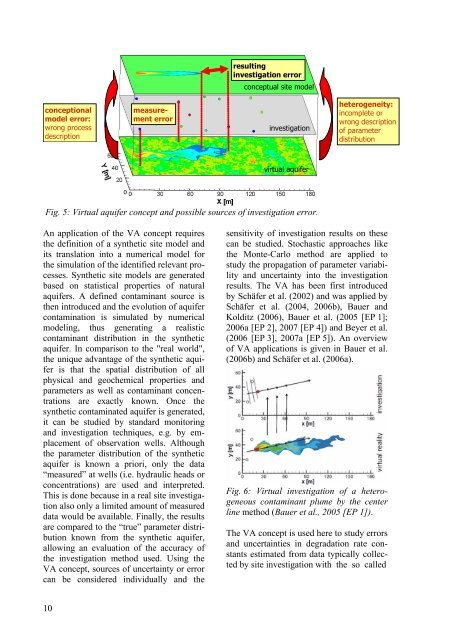Applied numerical modeling of saturated / unsaturated flow and ...
Applied numerical modeling of saturated / unsaturated flow and ...
Applied numerical modeling of saturated / unsaturated flow and ...
You also want an ePaper? Increase the reach of your titles
YUMPU automatically turns print PDFs into web optimized ePapers that Google loves.
conceptional<br />
model error:<br />
wrong process<br />
description<br />
10<br />
measurement<br />
error<br />
resulting<br />
investigation error<br />
conceptual site model<br />
investigation<br />
virtual aquifer<br />
Fig. 5: Virtual aquifer concept <strong>and</strong> possible sources <strong>of</strong> investigation error.<br />
An application <strong>of</strong> the VA concept requires<br />
the definition <strong>of</strong> a synthetic site model <strong>and</strong><br />
its translation into a <strong>numerical</strong> model for<br />
the simulation <strong>of</strong> the identified relevant processes.<br />
Synthetic site models are generated<br />
based on statistical properties <strong>of</strong> natural<br />
aquifers. A defined contaminant source is<br />
then introduced <strong>and</strong> the evolution <strong>of</strong> aquifer<br />
contamination is simulated by <strong>numerical</strong><br />
<strong>modeling</strong>, thus generating a realistic<br />
contaminant distribution in the synthetic<br />
aquifer. In comparison to the "real world",<br />
the unique advantage <strong>of</strong> the synthetic aquifer<br />
is that the spatial distribution <strong>of</strong> all<br />
physical <strong>and</strong> geochemical properties <strong>and</strong><br />
parameters as well as contaminant concentrations<br />
are exactly known. Once the<br />
synthetic contaminated aquifer is generated,<br />
it can be studied by st<strong>and</strong>ard monitoring<br />
<strong>and</strong> investigation techniques, e.g. by emplacement<br />
<strong>of</strong> observation wells. Although<br />
the parameter distribution <strong>of</strong> the synthetic<br />
aquifer is known a priori, only the data<br />
“measured” at wells (i.e. hydraulic heads or<br />
concentrations) are used <strong>and</strong> interpreted.<br />
This is done because in a real site investigation<br />
also only a limited amount <strong>of</strong> measured<br />
data would be available. Finally, the results<br />
are compared to the “true” parameter distribution<br />
known from the synthetic aquifer,<br />
allowing an evaluation <strong>of</strong> the accuracy <strong>of</strong><br />
the investigation method used. Using the<br />
VA concept, sources <strong>of</strong> uncertainty or error<br />
can be considered individually <strong>and</strong> the<br />
heterogeneity:<br />
incomplete or<br />
wrong description<br />
<strong>of</strong> parameter<br />
distribution<br />
sensitivity <strong>of</strong> investigation results on these<br />
can be studied. Stochastic approaches like<br />
the Monte-Carlo method are applied to<br />
study the propagation <strong>of</strong> parameter variability<br />
<strong>and</strong> uncertainty into the investigation<br />
results. The VA has been first introduced<br />
by Schäfer et al. (2002) <strong>and</strong> was applied by<br />
Schäfer et al. (2004, 2006b), Bauer <strong>and</strong><br />
Kolditz (2006), Bauer et al. (2005 [EP 1];<br />
2006a [EP 2], 2007 [EP 4]) <strong>and</strong> Beyer et al.<br />
(2006 [EP 3], 2007a [EP 5]). An overview<br />
<strong>of</strong> VA applications is given in Bauer et al.<br />
(2006b) <strong>and</strong> Schäfer et al. (2006a).<br />
Fig. 6: Virtual investigation <strong>of</strong> a heterogeneous<br />
contaminant plume by the center<br />
line method (Bauer et al., 2005 [EP 1]).<br />
The VA concept is used here to study errors<br />
<strong>and</strong> uncertainties in degradation rate constants<br />
estimated from data typically collected<br />
by site investigation with the so called

















